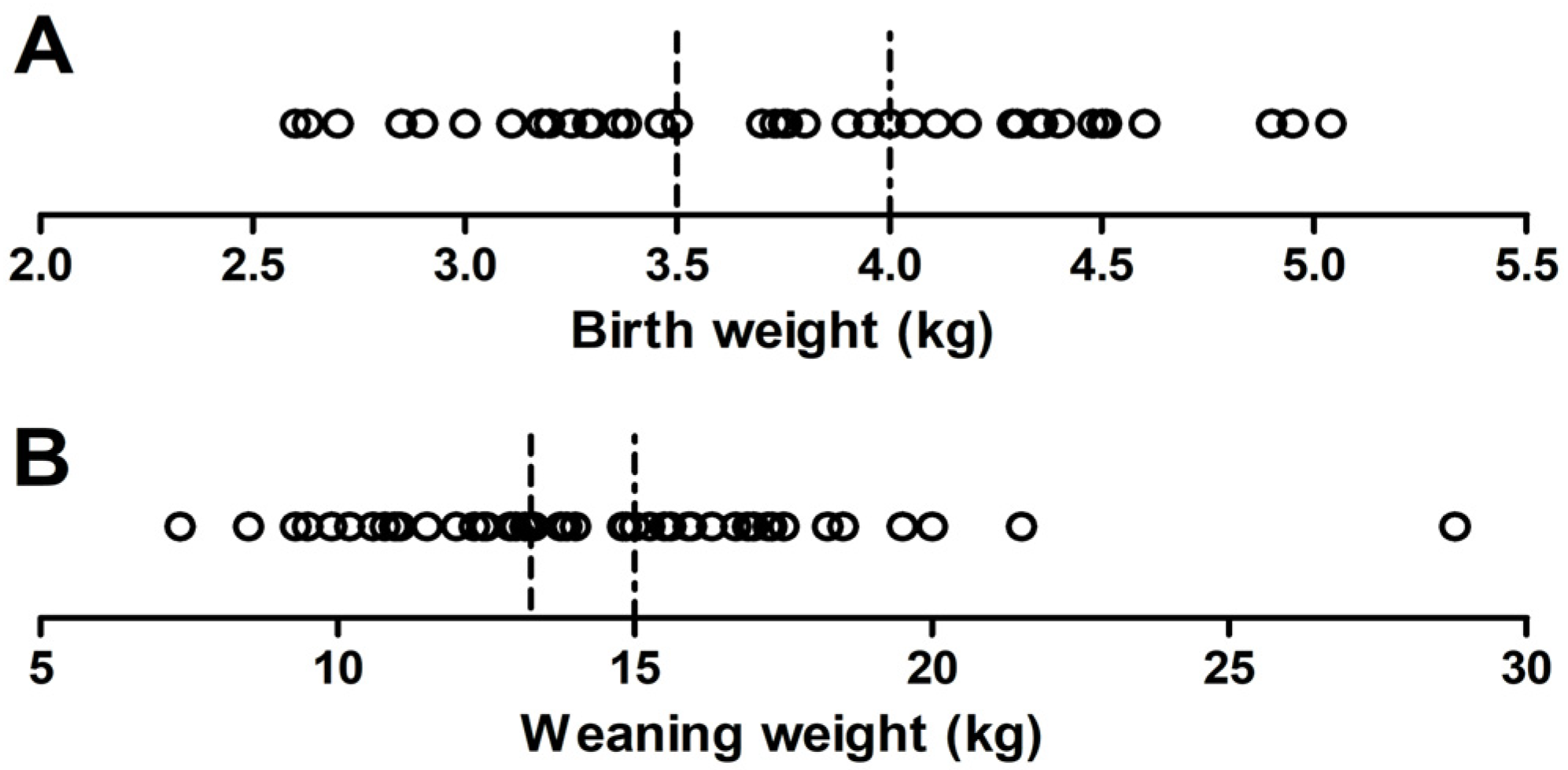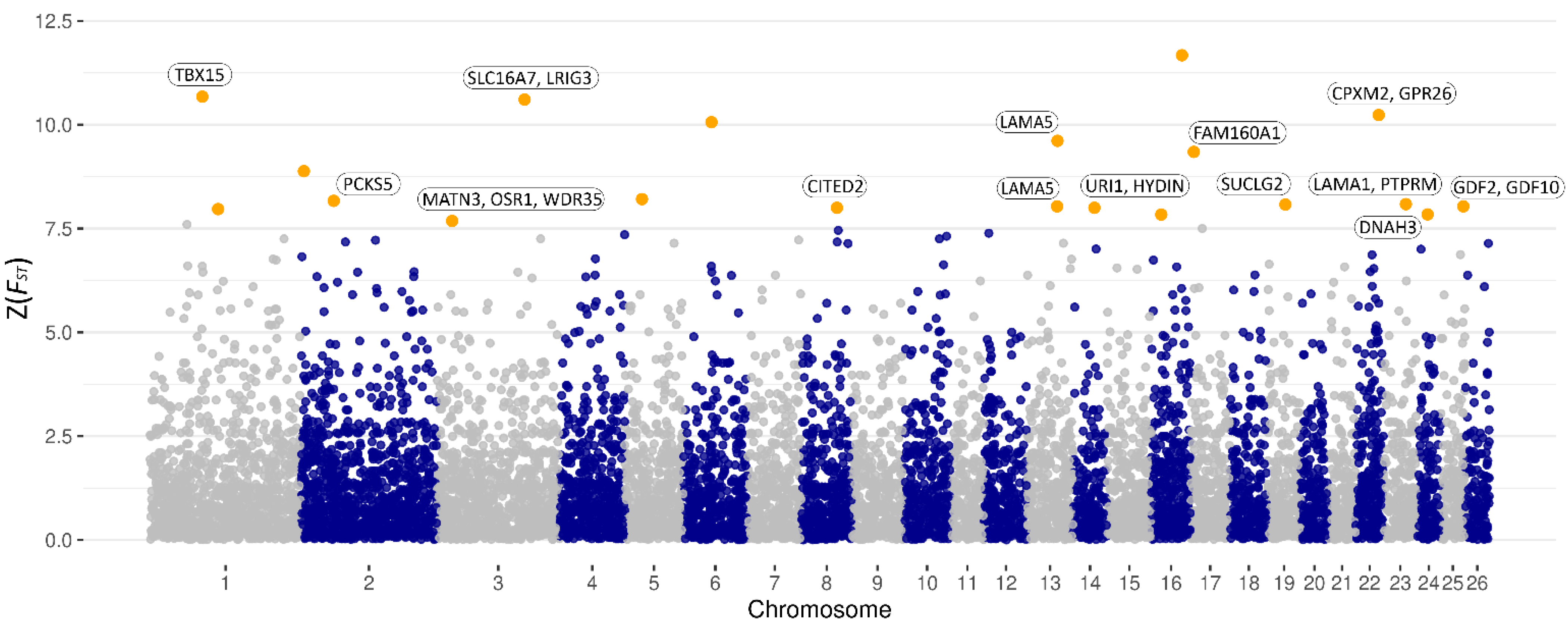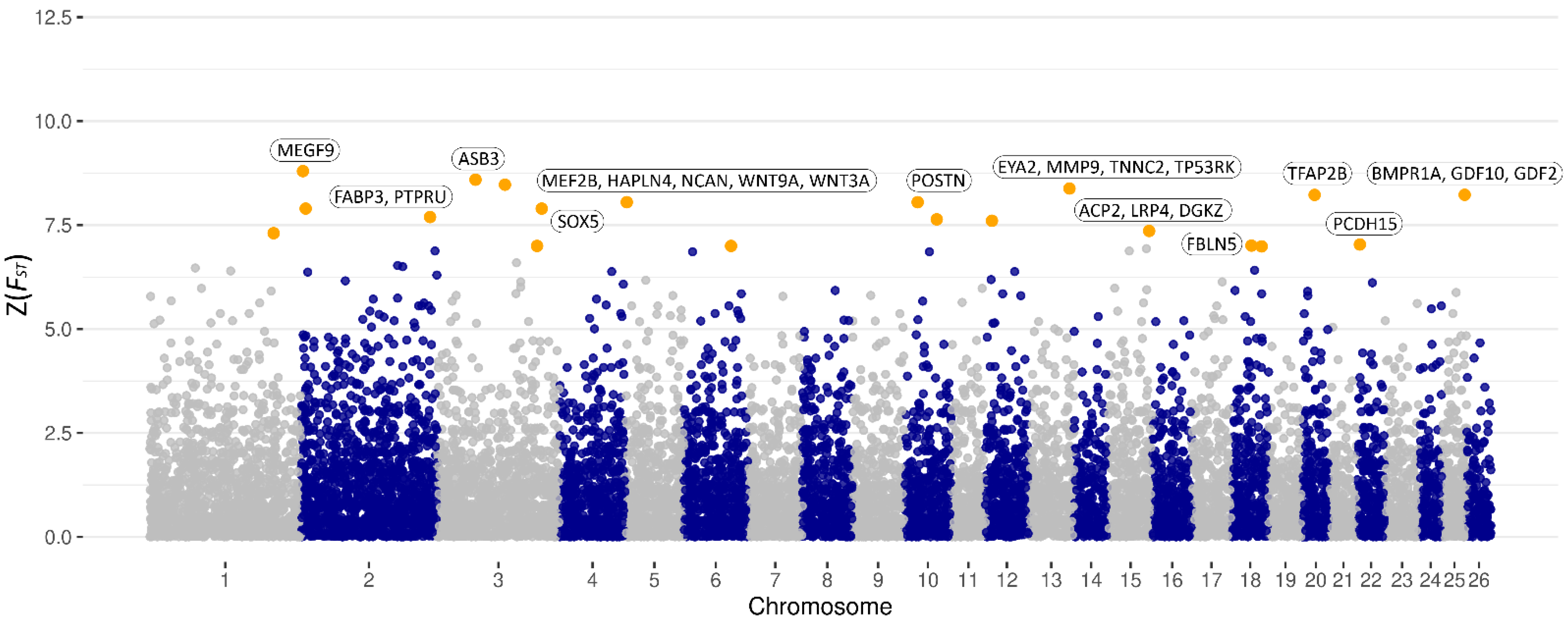Genome-Wide Analysis for Early Growth-Related Traits of the Locally Adapted Egyptian Barki Sheep
Abstract
1. Introduction
2. Materials and Methods
2.1. Animals and Phenotypes
2.2. Genotyping and Quality Control
2.3. FST Analysis and Screening for Candidate Genes
2.4. Marker–Trait Association Analysis
3. Results
3.1. Phenotypic Data of Growth Traits
3.2. Detection of Genomic Regions and Candidate Genes
4. Discussion
5. Conclusions
Supplementary Materials
Author Contributions
Funding
Institutional Review Board Statement
Data Availability Statement
Acknowledgments
Conflicts of Interest
References
- Smith, J.M.; Haigh, J. The hitch-hiking effect of a favourable gene. Genet. Res. 2007, 89, 391–403. [Google Scholar] [CrossRef]
- Kijas, J.W.; Lenstra, J.; Hayes, B.; Dalrymple, B. Genome-wide analysis of the world’s sheep breeds reveals high levels of historic mixture and strong recent selection. PLoS Biol. 2012, 10, e1001258. [Google Scholar] [CrossRef]
- Purfield, D.C.; McParland, S.; Wall, E.; Berry, D. The distribution of runs of homozygosity and selection signatures in six commercial meat sheep breeds. PLoS ONE 2017, 12, e0176780. [Google Scholar] [CrossRef]
- Rochus, C.M.; Tortereau, F.; Plisson-Petit, F.; Servin, B. Revealing the selection history of adaptive loci using genome-wide scans for selection: An example from domestic sheep. BMC Genom. 2018, 19, 71. [Google Scholar] [CrossRef]
- Ghasemi, M.; Zamani, P.; Vatankhah, M.; Abdoli, R. Genome-wide association study of birth weight in sheep. Animal 2019, 13, 1797–1803. [Google Scholar] [CrossRef] [PubMed]
- Yurchenko, A.A.; Deniskova, T.; Yudin, N.; Reyer, H.; Wimmers, K.; Larkin, D. High-density genotyping reveals signatures of selection related to acclimation and economically important traits in 15 local sheep breeds from Russia. BMC Genom. 2019, 20, 294. [Google Scholar] [CrossRef] [PubMed]
- Zhao, F.; McParland, S.; Du, L.; Berry, D. Detection of selection signatures in dairy and beef cattle using high-density genomic information. Genet. Sel. Evol. 2015, 47, 49. [Google Scholar] [CrossRef] [PubMed]
- El-Halawany, N.; Zhou, X.; Al-Tohamy, A.; El-Sayd, Y.; Shawky, A.; Michal, J.; Jiang, Z. Genome-wide screening of candidate genes for improving fertility in Egyptian native Rahmani sheep. Anim. Genet. 2016, 47, 513. [Google Scholar] [CrossRef]
- Burren, A.; Neuditschko, M.; Signer-Hasaler, H.; Flury, C. Genetic diversity analyses reveal first insights into breed-specific selection signatures within Swiss goat breeds. Anim. Genet. 2016, 47, 727–739. [Google Scholar] [CrossRef]
- Kim, E.S.; Elbeltagy, A.; Aboul-Naga, A.; Rothschild, M. Multiple genomic signatures of selection in goats and sheep indigenous to a hot arid environment. Heredity 2016, 116, 255–264. [Google Scholar] [CrossRef]
- McRae, K.M.; McEwan, J.; Dodds, K.; Gemmell, N. Signatures of selection in sheep bred for resistance or susceptibility to gastrointestinal nematodes. BMC Genom. 2014, 15, 637. [Google Scholar] [CrossRef]
- Shrestha, J.N.B.; Vesely, J.A.; Chesnais, J.P. Genetic and phenotypic parameters for daily gain and body weights in Suffolk lambs. Can.J. Anim. Sci. 1985, 65, 575–582. [Google Scholar] [CrossRef]
- Fitzmaurice, S.; Conington, J.; McHugh, N.; Banos, G. Towards future genetic evaluations for live weight and carcass composition traits in UK sheep. Small Rumin. Res. 2021, 196, 106327. [Google Scholar] [CrossRef]
- Harvey, C.F.; Larry, A.K.; Richard, M.T.; Warren, M.S. Heritability and genetic correlations of feed intake, body weight gain, residual gain, and residual feed intake of beef cattle as heifers and cows. J. Anim. Sci. 2020, 98, skz394. [Google Scholar] [CrossRef]
- Wei, C.H.L.; Liu, C.S. Encyclopedia of Modern Sheep Production Technology; Agriculture Press: Beijing, China, 2014; pp. 70–77. [Google Scholar]
- Ptáček, M.; Ducháček, J.; Stádník, L.; Hakl, J.; Fantová, M. Analysis of multivariate relations among birth weight, survivability traits, growth performance, and some important factors in Suffolk lambs. Arch. Anim. Breed. 2017, 60, 43–50. [Google Scholar] [CrossRef]
- Zamani, P.; Mohammadi, H. Comparison of different models for estimation of genetic parameters of early growth traits in the Mehraban sheep. J. Anim. Breed. Genet. 2008, 125, 29–34. [Google Scholar] [CrossRef] [PubMed]
- Sallam, A.M.; Ibrahim, A.H.; Alsheikh, S.M. Estimation of genetic parameters and variance components of pre-weaning growth traits in Barki lambs. Small Rumin. Res. 2019, 173, 94–100. [Google Scholar] [CrossRef]
- Abousoliman, I.; Reyer, H.; Oster, M.; Murani, E.; Wimmers, K. Analysis of candidate genes for growth and milk performance traits in the Egyptian Barki sheep. Animals 2020, 10, 197. [Google Scholar] [CrossRef] [PubMed]
- Sallam, A.M. A missense mutation in the coding region of the toll-like receptor 4 (TLR4) gene affects milk traits in Barki sheep. Anim. Biosci. 2021, 34, 489–498. [Google Scholar] [CrossRef]
- Weir, B.S.; Cockerham, C.C. Estimating f-statistics for the analysis of population structure. Evolution 1984, 38, 1358–1370. [Google Scholar] [CrossRef]
- Zheng, X.; Levine, D.; Shen, J.; Laurie, C.; Weir, B. A high-performance computing toolset for relatedness and principal component analysis of SNP data. Bioinformatics 2012, 28, 3326–3328. [Google Scholar] [CrossRef]
- Phipson, B.; Smyth, G.K. Permutation p-values should never be zero: Calculating exact p-values when permutations are randomly drawn. Stat. Appl. Genet. Mol. Biol. 2010, 9, 39. [Google Scholar] [CrossRef]
- De Las Heras-Saldana, S.; Clark, S.A.; Duijvesteijn, N.; Gondro, C.; van der Werf, J.H.J.; Chen, Y. Combining information from genome-wide association and multi-tissue gene expression studies to elucidate factors underlying genetic variation for residual feed intake in Australian Angus cattle. BMC Genom. 2019, 20, 939. [Google Scholar] [CrossRef] [PubMed]
- Shannon, P.; Markiel, A.; Ozier, O.; Baliga, N.S.; Wang, J.T.; Ramage, D.; Amin, N.; Schwikowski, B.; Ideker, T. Cytoscape: A software environment for integrated models of biomolecular interaction networks. Genome Res. 2003, 13, 2498–2504. [Google Scholar] [CrossRef]
- Bindea, G.; Mlecnik, B.; Hackl, H.; Galon, J. ClueGO: A Cytoscape plug-in to decipher functionally grouped gene ontology and pathway annotation networks. Bioinformatics 2009, 25, 1091–1093. [Google Scholar] [CrossRef]
- Marai, I.F.M.; Daader, A.H.; Bahgat, L.B. Performance traits of purebred Ossimi and Rahmani lambs and their crosses with Finnsheep born under two accelerated mating systems. Arch. Anim. Breed. 2009, 52, 497–511. [Google Scholar] [CrossRef]
- Abd-Allah, M.; Abass, S.; Allam, F. Reproductive performance of Rahmani and Chios sheep and their lambs under Upper Egypt conditions. Online J. Anim. Feed Sci. 2011, 1, 121–129. [Google Scholar]
- Thomson, B.C.; Muir, P.D.; Smith, N.B. Litter size, lamb survival, birth and twelve week weight in lambs born to cross-bred ewes. J. N. Z. Grassl. 2004, 66, 233–237. [Google Scholar] [CrossRef]
- Animal QTL Database—Animal Genome Databases. Available online: https://www.animalgenome.org/cgi-bin/QTLdb/OA/ontrait?trait_ID=3228 (accessed on 29 July 2021).
- Papaioannou, V.E. T-box genes in development: From hydra to humans. Int. Rev. Cytol. 2001, 207, 1–70. [Google Scholar] [CrossRef] [PubMed]
- Gibson-Brown, J.J.; Agulnik, S.; Chapman, D.; Garvey, N.; Papaioannou, V. Evidence of a role for T-box genes in the evolution of limb morphogenesis and the specification of forelimb/hindlimb identity. Mech. Dev. 1996, 56, 93–101. [Google Scholar] [CrossRef]
- Candille, S.I.; Chen, C.; Russ, A.; Barsh, G. Dorsoventral Patterning of the Mouse Coat by Tbx15. PLoS Biol. 2004, 2, e3. [Google Scholar] [CrossRef] [PubMed]
- Carraro, L.; Ferrarasso, S.; Cardazzo, B.; Bargelloni, L. Expression profiling of skeletal muscle in young bulls treated with steroidal growth promoters. Physiol. Genom. 2009, 38, 138–148. [Google Scholar] [CrossRef] [PubMed][Green Version]
- Metodiev, S.; Young, J.; Onteru, S.; Rothschild, M.; Dekkers, J. A whole-genome association study for litter size and litter weight traits in pigs. Livest Sci. 2018, 211, 87–97. [Google Scholar] [CrossRef]
- Pérez-Montarelo, D.; Madsen, O.; Alves, E.; Fernandez, A. Identification of genes regulating growth and fatness traits in pig through hypothalamic transcriptome analysis. Physiol. Genom. 2014, 46, 195–206. [Google Scholar] [CrossRef]
- Firulli, A.B.; Miano, J.; Bi, W.; Johnson, A.; Schwarz, J. Myocyte enhancer binding factor-2 expression and activity in vascular smooth muscle cells. Association with the activated phenotype. Circ. Res. 1996, 78, 196–204. [Google Scholar] [CrossRef]
- Iida, K.; Hidaka, K.; Takeuchi, M.; Yutani, C.; Morisaki, T. Expression of MEF2 genes during human cardiac development. Tohoku J. Exp. Med. 1999, 187, 15–23. [Google Scholar] [CrossRef]
- Zhang, L.; Ma, X.; Xuan, J.; Wang, H.; Wu, M.; Du, L. Identification of MEF2B and TRHDE gene polymorphisms related to growth traits in a new Ujumqin sheep population. PLoS ONE 2016, 11, e0159504. [Google Scholar] [CrossRef]
- HE Bo, Z.R.; Yuanzhu, X.; Hu, C. Culture, Identification and biological characteristics of skeletal muscle satellite cells of the Neonatal pig. Acta Vet. Zootech. Sin. 2006, 6, 555–559. [Google Scholar]
- Chen, L.; Cheng, B.; Li, L.; Zhan, S.; Zhong, T.; Chen, Y.; Zhang, H. The molecular characterization and temporal-spatial expression of myocyte enhancer factor 2 genes in the goat and their association with myofiber traits. Gene 2015, 555, 223–230. [Google Scholar] [CrossRef]
- Ahbara, A.; Bahbahani, H.; Almathen, F.; Agoub, M.; Mwacharo, J. Genome-wide variation, candidate regions and genes associated with fat deposition and tail morphology in Ethiopian indigenous sheep. Front. Genet. 2019, 9, 1–21. [Google Scholar] [CrossRef]
- Farah, C.S.; Reinach, F.C. The troponin complex and regulation of muscle contraction. FASEB J. 1995, 9, 755–767. [Google Scholar] [CrossRef]
- Bucher, E.A.; Maisonpierre, P.; Konieczny, S.; Emerson, C. Expression of the troponin complex genes: Transcriptional coactivation during myoblast differentiation and independent control in heart and skeletal muscles. Mol. Cell. Biol. 1988, 8, 4134–4142. [Google Scholar] [CrossRef] [PubMed]
- Li, Y.; Chen, Y.; Li, J.; Wang, C.; Liu, X.; Ling, F.; Zhong, W. Molecular characterization, expression profile and polymorphisms of the porcine TNNC2 gene. Hereditas 2008, 145, 274–282. [Google Scholar] [CrossRef] [PubMed]
- Xu, Q.; Kang, K.; Yan, F.; An, J.; Chen, Y. Characterization of the fast skeletal troponin C (TNNC2) gene in three Chinese native sheep breeds. Arch. Anim. Breed. 2008, 51, 572–581. [Google Scholar] [CrossRef][Green Version]
- Zhao, F.; Satoda, M.; Licht, J.; Hayashizaki, Y.; Gelb, B. Cloning and characterization of a novel mouse AP-2 transcription factor, AP-2delta, with unique DNA binding and transactivation properties. J. Biol. Chem. 2001, 276, 40755–40760. [Google Scholar] [CrossRef]
- Moser, M.; Pscherer, A.; Roth, C.; Becker, J.; Fassler, R. Enhanced apoptotic cell death of renal epithelial cells in mice lacking transcription factor AP-2beta. Genes Dev. 1997, 11, 1938–1948. [Google Scholar] [CrossRef]
- Tian-Ke, L.; Chun-Nian, L.; Xia, L.; Jie, P.; Xiao-Yun, W.; Min, C.; Wen, Q.; Ping, Y. GDF-10 Gene Polymorphism and Its Association with Production Traits in Gannan Yak. Sci. Agric. Sin. 2014, 47, 161–169. [Google Scholar] [CrossRef]
- Pickering, N.K. Genetics of Flystrike, Dagginess and Associated Traits in New Zealand Dual-Purpose Sheep. Ph.D. Thesis, Massey University, Palmerston North, New Zealand, 2013. [Google Scholar]
- Adoligbe, C.; Zan, L.; Farougou, S.; Wang, H.; Ujjan, J. Bovine GDF10 gene polymorphism analysis and its association with body measurement traits in Chinese indigenous cattle. Mol. Biol. Rep. 2012, 39, 4067–4075. [Google Scholar] [CrossRef]
- Hong, E.P.; Park, J.W. Sample Size and Statistical Power Calculation in Genetic Association Studies. Genom. Inform. 2012, 10, 117–122. [Google Scholar] [CrossRef] [PubMed]



| Trait | Abbreviation | Group * | N | Mean | SD | Min | Max | p-Value ** |
|---|---|---|---|---|---|---|---|---|
| Birth weight (kg) | BW | HBW | 31 | 4.3 | 0.3 | 4.0 | 5.0 | p < 0.001 |
| LBW | 24 | 3.2 | 0.3 | 2.6 | 3.5 | |||
| Weaning weight (kg) | WW | HWW | 28 | 18.1 | 2.5 | 15.0 | 28.8 | p < 0.001 |
| LWW | 23 | 11.2 | 1.7 | 7.4 | 13.3 |
| Rs Identifier | Chr | Position | MAF | Z(FST) | Permutation p Value 1 | Association p Value 2 | Candidate Genes 3 |
|---|---|---|---|---|---|---|---|
| rs426652102 | 1 | 95369397 | 0.335 | 10.68 | 0.0006 | 0.004 | TBX15, SPAG17 |
| rs409727057 | 1 | 124117118 | 0.220 | 7.97 | 0.001 | 0.003 | CLDN17, GRIK1 |
| rs423222301 | 2 | 5472326 | 0.301 | 8.88 | 0.0006 | 0.015 | BRINP1, TLR4 |
| rs419514091 | 2 | 60044110 | 0.369 | 8.17 | 0.0006 | 0.116 | PCKS5, RFK, ENSOARG00000012533 |
| rs428614465 | 3 | 27732721 | 0.492 | 7.68 | 0.0009 | <0.0001 | MATN3, OSR1, WDR35, TTC32 |
| rs417060060 | 3 | 160252310 | 0.446 | 10.61 | 0.0003 | 0.001 | SLC16A7, LRIG3 |
| rs413547561 | 5 | 31477570 | 0.481 | 8.21 | 0.001 | 0.144 | PRR16, FAM170A |
| rs413364871 | 6 | 51650705 | 0.301 | 10.06 | 0.0003 | 0.006 | -- |
| rs427385309 | 8 | 64075259 | 0.276 | 8.00 | 0.0006 | 0.156 | CITED2, U5, NMBR |
| rs406649973 | 13 | 54940415 | 0.444 | 9.61 | 0.0003 | 0.041 | LAMA5, CDH28, CDH4 |
| rs419112095 | 13 | 54219758 | 0.295 | 8.03 | 0.0009 | 0.166 | LAMA5, RPS21, ADRM1 |
| rs410323459 | 14 | 39415649 | 0.328 | 8.00 | 0.001 | 0.0006 | URI1, HYDIN, CMTR2, POP4 |
| rs423237115 | 16 | 56144068 | 0.412 | 11.67 | 0.0003 | 0.014 | MYO10 |
| rs413049228 | 16 | 18186560 | 0.134 | 7.84 | 0.009 | 0.058 | ZSWIM6, SMIM15 |
| rs413966946 | 17 | 6026379 | 0.465 | 9.34 | 0.0006 | 0.006 | FAM160A1, GATB, SH3D19 |
| rs430430903 | 19 | 33088813 | 0.289 | 8.08 | 0.0006 | 0.046 | SUCLG2, ENSOARG00000010424 |
| rs417719085 | 22 | 42323039 | 0.444 | 10.23 | 0.0003 | 0.002 | CPXM2, GPR26, ACADSB |
| rs412781362 | 23 | 41177245 | 0.127 | 8.07 | 0.0009 | 0.001 | LAMA1, PTPRM, RAB12 |
| rs421209784 | 24 | 18748352 | 0.086 | 7.84 | 0.0009 | 0.001 | DNAH3, LYRM1, TMEM159 |
| rs429736586 | 25 | 41911462 | 0.348 | 8.03 | 0.0003 | 0.064 | GDF2, GDF10, PTPN20 |
| Rs Name | Chr | Position | MAF | Z(FST) | Permutation p-Value 1 | Association p-Value 2 | Candidate Genes 3 |
|---|---|---|---|---|---|---|---|
| rs401497638 | 1 | 226047403 | 0.274 | 7.30 | 0.170 | 0.002 | IL12A, IQCJ |
| rs402362274 | 2 | 4014386 | 0.194 | 8.80 | 0.003 | 0.015 | MEGF9, CDK5RAP2, BRINP1 |
| rs427650461 | 2 | 8985061 | 0.259 | 7.90 | 0.003 | 0.018 | TNFSF15, TMEM268 |
| rs405054059 | 2 | 236085906 | 0.354 | 7.69 | 0.004 | 0.177 | FABP3, MATN1, PTPRU |
| rs420573745 | 3 | 70227376 | 0.500 | 8.59 | 0.003 | 0.077 | ASB3, CHAC2 |
| rs422502823 | 3 | 124010853 | 0.408 | 8.47 | 0.003 | 0.039 | MGAT4C, C12orf50 |
| rs425747978 | 3 | 191139722 | 0.269 | 7.90 | 0.003 | 0.067 | SOX5, BCAT1, ETNK1 |
| rs410754805 | 3 | 182669294 | 0.341 | 7.00 | 0.003 | 0.044 | RESF1, AMN1 |
| rs429678680 | 5 | 3076397 | 0.224 | 8.10 | 0.003 | 0.278 | MEF2B, HAPLN4, NCAN, WNT9A, WNT3A, PRSS38, SNAP47 |
| rs418926568 | 6 | 86505675 | 0.381 | 7.00 | 0.004 | 0.120 | SLC4A4, GC |
| rs401888979 | 10 | 25115607 | 0.219 | 8.10 | 0.003 | 0.002 | POSTN, RFXAP, SERTM1 |
| rs428497629 | 10 | 59974520 | 0.263 | 7.64 | 0.004 | 0.006 | SLITRK1, SLITRK6 |
| rs426943634 | 12 | 12266633 | 0.436 | 7.60 | 0.003 | 0.009 | RGS18, BRINP3 |
| rs413169429 | 13 | 74924747 | 0.303 | 8.38 | 0.003 | 0.009 | EYA2, MMP9, TNNC2, TP53RK, SLC13A3, SLC2A10 |
| rs411451096 | 15 | 74597812 | 0.399 | 7.36 | 0.003 | 0.128 | ACP2, LRP4, DGKZ, CREB3L1, MDK |
| rs430684800 | 18 | 36936501 | 0.322 | 7.01 | 0.003 | 0.009 | NOVA1, FOXG1 |
| rs426036565 | 18 | 55537048 | 0.414 | 6.99 | 0.003 | 0.495 | FBLN5, TC2N, TRIP11 |
| rs410079568 | 20 | 23394498 | 0.470 | 8.23 | 0.003 | 0.143 | TFAP2B, PKHD1 |
| rs421690996 | 22 | 5090223 | 0.345 | 7.03 | 0.003 | 0.026 | PCDH15, U3, SYCE1 |
| rs400432841 | 25 | 41241866 | 0.459 | 8.23 | 0.003 | 0.039 | BMPR1A, GDF10, GDF2, GLUD1, U6, SHLD2 |
Publisher’s Note: MDPI stays neutral with regard to jurisdictional claims in published maps and institutional affiliations. |
© 2021 by the authors. Licensee MDPI, Basel, Switzerland. This article is an open access article distributed under the terms and conditions of the Creative Commons Attribution (CC BY) license (https://creativecommons.org/licenses/by/4.0/).
Share and Cite
Abousoliman, I.; Reyer, H.; Oster, M.; Murani, E.; Mohamed, I.; Wimmers, K. Genome-Wide Analysis for Early Growth-Related Traits of the Locally Adapted Egyptian Barki Sheep. Genes 2021, 12, 1243. https://doi.org/10.3390/genes12081243
Abousoliman I, Reyer H, Oster M, Murani E, Mohamed I, Wimmers K. Genome-Wide Analysis for Early Growth-Related Traits of the Locally Adapted Egyptian Barki Sheep. Genes. 2021; 12(8):1243. https://doi.org/10.3390/genes12081243
Chicago/Turabian StyleAbousoliman, Ibrahim, Henry Reyer, Michael Oster, Eduard Murani, Ismail Mohamed, and Klaus Wimmers. 2021. "Genome-Wide Analysis for Early Growth-Related Traits of the Locally Adapted Egyptian Barki Sheep" Genes 12, no. 8: 1243. https://doi.org/10.3390/genes12081243
APA StyleAbousoliman, I., Reyer, H., Oster, M., Murani, E., Mohamed, I., & Wimmers, K. (2021). Genome-Wide Analysis for Early Growth-Related Traits of the Locally Adapted Egyptian Barki Sheep. Genes, 12(8), 1243. https://doi.org/10.3390/genes12081243







